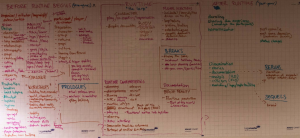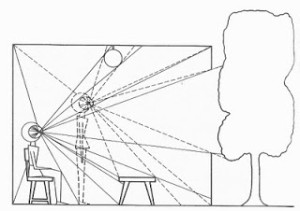Note: This case study is building towards a larger theory, as proposed in my Topic Proposal Redux. In that theory, I will use Guattari, Gibson, Bateson, Norman, and other theorists related to the affordances and constraints of an ecosystem and ecologies. I will also bring in multiple levels of play (as written, as played, as remembered) and the types of play displayed by various members of the ecosystem (Forge Theory, Edwards, Bøckman). I will relate that to the larp as a rhetorical situation with multiple rhetors (who are simultaneously the audience) and to the movement between diegetic and non-diegetic worlds (a system within a system) as expressed by Montola and others. The graphic below is a chart that delineates some of the connections I am making among the various theories. Though this is too complex to entertain in the short space of 2,500 words here, I am giving a taste of what is to come. In this space, I will discuss how I arrived at the idea of larp as an ecosystem, discuss how it behaves as one as well as how its phases correspond to Guattari’s ecologies. I will also discuss a pedagogical tool that can be used as a theoretical lens to analyze the designed affordances and constraints of a given larp. I will not yet discuss the tension between these designed or inherent affordances and constraints and those perceived by the players or characters – that will be developed in the final theory.
Literature Review
Finnish larp theorist Jaako Stenros delineates what he calls three “aspects” of larp in his Aesthetics of Action conference presentation. He lists the “framework” as designed by the larpwrights as the first or primary aspect, consisting of background material, the sketch of the roles and their social network, game mechanics, and sometimes character outlines. The second aspect is the larp runtime, during which the larp’s first level is turned over to the influence of the players, who create the experience. Stenros notes that this larp aspect is ephemeral and dynamic: “the players can run away with it” and “it is lost the moment the larp [allotted gametime] ends.” His third aspect is the larp “as remembered, interpreted, and documented” during which the players come together to share their individual experiences of the larp as played, and to co-create a kind of communal meaning of the experience. Markus Montola (2009) notes that larps use the principle of equifinality, or multiple paths to the same end state. This agreed-upon end state is co-constructed during the third aspect of larp, which follows the actual game. However, as Stenros reiterates, this is not to be considered a finite resolution that is simply decided upon once and codified. Rather, “as the piece [the particular instantiation of a larp] is debated later, discussed and critiqued, its meaning continues to shift” (Aesthetics).
I will summarize Stenros’s three aspects as 1. Larp As Written; 2. Larp As Played and 3. Larp As Remembered or Narrated, noting that the three levels take place before, during, and after the runtime of a particular iteration or instantiation of a larp. Stenros goes on to discuss the activity of the three aspects as framing, building/enriching and negotiating. The table below summarizes these simultaneous concepts:
| Phase or Aspect | Timeframe | Primary Activity |
| As written | Prior to game-play | Framing |
| As played | During game-play | Building, enriching, interpreting |
| As remembered | After game-play | Negotiating and narrativizing |
Here is a brainstorm of the activity that takes place pre-larp, during-larp, and post-larp:
These three phases of larp seem to create an ecosystem of larp, where any given larp is an interactive system moving within and between these three aspects — as the network or system is created, enacted, and dissolved. Ecosystems are ways to explain things that are dynamic, in a state of flux, and whose outcomes/outputs cannot be fully predicted mechanically or even computationally or logarithmically. An ecosystem is concerned with movement, distribution, exchange, and transformation enacted by invested, adaptable members who together co-create the system through production and consumption in relationship with one another.
 Ecologies are fundamentally dynamic networks in that they exist only in the relationships, in the movement among the nodes, which operates according to protocols unique to each member, but translated into a working, mutually beneficial partnership. Of course, a larp is a constructed ecosystem, a world made by intelligent design – at least the geometry and geography or framework of it, as discussed above. In a larp, people are portraying roles within the constructed game-space ecosystem that is nested inside the outer ecosystem of the mundane world. This system is an ecosystem because it is dynamic, teeming, and alive, with each player occupying a particular niche and behaving according to his/her own perceptions and interpreting his/her own diegesis. Indeed, as Stenros notes, “Role-play is pretend play with a social context and shared rules” (Aesthetics, emphasis added).
Ecologies are fundamentally dynamic networks in that they exist only in the relationships, in the movement among the nodes, which operates according to protocols unique to each member, but translated into a working, mutually beneficial partnership. Of course, a larp is a constructed ecosystem, a world made by intelligent design – at least the geometry and geography or framework of it, as discussed above. In a larp, people are portraying roles within the constructed game-space ecosystem that is nested inside the outer ecosystem of the mundane world. This system is an ecosystem because it is dynamic, teeming, and alive, with each player occupying a particular niche and behaving according to his/her own perceptions and interpreting his/her own diegesis. Indeed, as Stenros notes, “Role-play is pretend play with a social context and shared rules” (Aesthetics, emphasis added).
In an ecosystem, every entity has a role, according to his/her affordances and constraints, in order to keep the system moving toward its goal of homeostasis, during which an individual population or an entire ecosystem regulates itself against negative factors and maintains an overall stable condition (Spellman 20). Spellman identifies roles into two categories: living (biotic) and non-living (abiotic) (15). He further divides the abiotic components into three categories: inorganic substances, organic compounds, and climate regime. I will return to these three levels as depicted in a larp later, when I discuss artifacts and The Mixing Desk. Defining an ecosystem as “a cyclic mechanism in which biotic and abiotic materials are constantly exchanged”, Spellman delineates levels of production and consumption of these materials (15-16). I have added this column to my larp grid below to demonstrate how these roles and levels of production/consumption fit into the ecosystem of a larp:
| Level or Aspect | Timeframe | Primary Activity | Ecosystem Role |
| As written | Prior to game-play | Framing | Primary producer |
| As played | During game-play | Building, enrichingInterpreting | Primary Consumer |
| As remembered | After game-play | Negotiating and narrativizing | Secondary consumer &Decomposer |
We can then add the actual larp roles:
| Level or Aspect | Timeframe | Primary Activity | Ecosystem Role | Larp role |
| As written | Prior to game-play | Framing | Primary producer | GameMaster/ Larpwright |
| As played | During game-play | Building, enrichingInterpreting | Primary Consumer | Individual players |
| As remembered | After game-play | Negotiating and narrativizing | Secondary consumer &Decomposer | Community of playersGameMaster/ Larpwright |
So the larp ecosystem continuous cycle would look like this, with the green level being before a larp runtime begins, the blue level being during larp runtime, and the red and orange being post-larp runtime:

Demonstrates the dynamics of play among the roles of production and consumption. Upon completing one cycle, another instantiation of the larp as played is ready to begin.
Indeed, both players in a larp and members of an ecosystem appear to continually assess its affordances and constraints, with their own survival and needs as paramount. A player-character in a larp also functions this way, following a path and plan in the game ecosystem that is based on two types of survival/needs assessment: in-game and out-of-game. In game elements: skills, relationships, goals, revealed secrets, mechanics are designed by the GameMasters or co-created against constraints given by GMs, the genre, or the world of the game. Out-of-game elements may refer to the player’s preferred play style, as a Gamist, Dramatist, or Immersionist, to use Bøckman’s “Three-Way Model” (2003). This dominant play style for each player helps determine the approach they take to the ecosystem, and how they perceive their niche within it. Dramatists, called Narrativists in Edwards’ Forge Theory Model (2001) are concerned with in-game action and plot, with the primary goal to create a satisfying story (Bøckman 14; Edwards Ch. 2). Dramatists perceive the game as affording opportunities for a cohesive and believable narrative, and choose to use or conserve resources with that goal in mind. Gamists are problem-solvers who use strategy to advance their in-game (and, often, out-of-game) social or material capital. Their goal is to survive and thrive, and will make calculations about resources in the game (or mundane) ecosystem(s) to ensure their own longevity and comfort (Bøckman, Edwards). Lastly, Immersionists (known as Simulationists in Edwards’ model) want to be fully engaged in the game ecosystem without any bleed from the outside mundane ecosystem that constructed it. As Bøckman explains, “a fully immersionist player will not fudge rules to save its role’s neck or the plot” (13). If the character is meant to, must, or otherwise cannot avoid harm in the constraints of the game’s ecosystem, an Immersionist will allow that to happen and focus on fulfilling that given role.
So, we may further break down the ecosystem roles into the three role-playing models of Gamist, Narrativist, and Simulationist as three types of protocols governing the design and play of the larp in the three phases of writing, playing, and remembering. It is important to remember that these are neither static nor fixed roles: a player may be predominantly Gamist but also enjoy a good story, or may consciously seek an Immersionist experience but become more Gamist when a character’s survival is threatened. These typologies are also not necessarily fully inclusive; some theorists suggest a fourth level: the social. Under that paradigm, I would agree that the larp ecosystem itself is the social level, providing the space of enactment for players and Gamemasters to interact and enact their fluid play styles. This notion of role perception, which is how I see this theory as being valuable, is both a design element and a play element. A good GM should design games with elements of all three types of interaction with the game: an ecosystem that affords activity and enjoyment for all members.
The three play models of Gamist, Dramatist/Narrativist, and Immersionist/ Simulationist cannot be easily added to the matrix we have been building. They exist within each of the ecologies, not strictly within a single phase or role. Players make choices both during the game and in the post-game debrief that are based on their preferences, but, I am arguing, more on their perceptions. These include perceptions of their role, themselves, the Gamemaster, other players, other characters, their abilities, their character skills, the physical environment, the game environment, their likelihood of success, their energy level, gametime remaining, and a host of other ecological factors – both in the ecosystem of the game and the larger mundane ecosystem surrounding and influencing it. GMs design games with more of one interaction than another, and steer characters and game development toward that preferred end during a game. In short, both GMs and players design, steer, and enact role-playing games based on the affordances they perceive at a given moment in time, what Syverson refers to as a spatio-temporal reality.
J.J. Gibson (1977, 1979) introduced the concept of affordances, which he defined as “an action possibility available in the environment to an individual” (127). According to Gibson, these “actionable properties” are objectively measurable, independent of an individual’s ability to recognize them. To Gibson an affordance exists in relationship with an individual; it is intended to offer an action to another; however, the affordance exists regardless of whether any actor perceives it.
Gibson puts forward the Law of Ambient Optic Array as a theory of optics that attempts to demonstrate what and how individuals see in a given environment. He notes that perception is determined by the individual from information accessed in the environment and then assessed in terms of its possibilities and usefulness to create the aforementioned affordances. Gibson notes the importance of the position of the observer to what is perceived, since “at any fixed point of observation some parts of the environment are revealed and the remaining parts are concealed” (136). This idea of the personal position of experience in an ecosystem is hugely important in larp. As Stenros reminds us, when role-playing, “You will only see what your character sees. You will only be able to witness those parts of the larp where your character is present, where you, bodily, are present. You are the lens or the camera through which you see the work unfold around you” (Aesthetics).
As an individual player, you create an individual perception and experience of the larp; the game exists for you, in your mind, in relation to the environment. Montola (2003) states that, “every participant constructs he or her diegesis when playing” and “the crucial process of role-playing [is] the interaction of these diegeses” (83). This takes place in the second phase of larp, or larp as played, as well as, to a lesser extent, in the third phase of larp, larp as remembered. A single player’s diegesis is their view of the world, which they interpret as a series of affordances and constraints based on abiotic and biotic factors from the diegetic and non-diegetic world, such as (but not limited to) character sheets, skills, experience, knowledge of plot, knowledge of game world, information from other players/characters, etc. In Actor-Network Theory, this information would be the connected nodes flowing into an actor; here, these are affordances of an ecosystem perceived and interpreted by agents who make decisions based on this information, within the constraints of the physical or brute world and the in-game world. In larp, as a constructed ecosystem, this relationship between agent and his/her environment is complicated, because the character/player exists in a layered double consciousness and simultaneity, even though s/he intends to interact in the diegetic world via immersion and will attempt to make decisions based primarily on that environment. As Stenros points out, “[l]arp is embodied participatory drama. As a participant, you are experiencing the events as a character, but also shape the drama as it unfolds as a player (Aesthetics). However, as Montola, Saitta and Stenros (2014) note, a player/character will often “steer,” or use information and impetus from the non-diegetic world with the purpose of affecting the diegetic world for individual or community goals. Gibson noted this duality of position as he remarked about the law of ambient optic array, whereby “the observer himself, his body considered as part of the environment, is revealed at some fixed points of observation and concealed at the remaining points” (Gibson 136). There are times in an ecosystem, and certainly in a role-playing game, when the individual is aware of him or herself. In the case of a larp, I propose, these are moments where immersion breaks, and a player makes an in-game decision based on out-of-game knowledge or preferences, the definition of “steering” put forth by Montola, Saitta and Stenros (2014).
According to ecologies theorists, ecosystems can be measured in terms of their abundances and their efficiencies, what resources are plentiful and how they are distributed, used, and used up within the system. These are the kinds of settings that are engineered, or designed, in a constructed ecosystem, such as a larp. Don Norman (1988) revised Gibson’s idea of affordance to create the concept of “perceived affordances” which amount to what a user/actor believes to be possible (or not possible), and are independent of the real affordances an object or environment may have. Thus, for a Gibsonian affordance to be actualized or enacted, it is dependent on the individual actor’s ability to both perceive it and his or her capability to use it. Norman cares about perceived affordances because that is what the designer has control over in terms of a user’s experience. And designing, interpreting, and analyzing a larp’s affordances and constraints is where we now turn.
As we attempt to determine what a larp affords, and what makes a good larp, I will turn to a recent development out of the Nordic community, “The Mixing Desk of Larp” (2012), which uses the analogy of the audio-visual technician creating a live experience to create a series of “sliders” or “faders” that can be manipulated to produce a desired type of play. The Mixing Desk is a visualization of the inputs that go into an ecosystem to determine outputs, and it helps to describe the protocols and territories in play in a particular game ecosystem. One of the primary creators of the system, Martin Andresen said, The Mixing Desk “allows us to visualize the opportunities in larp design” and functions to “make larpwriters/designers aware of their default positions” (Andresen).
While primarily developed as a tool to help take something complicated, such as larp theory and design, and turn it into a pedagogical aid that visualizes important concepts and organizes around a simple metaphor in order to help inexperienced larpers and larpwrights to design playable games, The Mixing Desk of Larp is an excellent tool to use to analyze the affordances and constraints of a particular larp, both as it is written and as it is played. The faders each represent a design element of the larp, or a construction of the relationship between players, players and GM, the outputs of the game. The faders are the INPUTS and the game is the OUTPUT, at least on the first level of being written. The first level “Larp as Written” is the wireframe that becomes the larp. Using The Mixing Desk of Larp to consciously construct the first level of larp: “As written” is an excellent way to afford “The Larp”, which is “as played”, the level of interaction within the ecosystem created using the faders on the mixing desk (controlling the inputs into the system). However, as the larp is played, a Gamemaster, or in some cases, a player or group of players, can change the levels of the mixing desk dynamically during play, either as a result of individual or collective action that required intervention by the GM to keep the levels at their desired positions, or as a result of “steering” or conscious behavior that uses non-diegetic knowledge to affect the dramatic experience and/or outcome of the larp as played. The Mixing Desk of larp can be used as a Mobius strip to continually test and tweak the desired inputs and outputs of the larp to achieve homeostasis – the desired characteristic of the ecosystem.
Where this is going (undeveloped thoughts, not part of the “complete” Case Study #3)
(I’m including this in case you wish to offer feedback re: the direction and conclusions)
- More about the mixing desk and the affordances listed there
- These are notes and quotes re: relationship of player/character to environment
- Perceived vs. designed affordances
- Outcome of play phases 2 and 3
- Relationship of self to world — dual world consciousness
- Steering & Metagaming
What happens when, as Bateson outlines in his chapter “Form, Substance, and Difference,” we see ourselves as separate and above the natural world– “If you put God outside and set him vis-a-vis his creation and if you have the idea that you are created in his image, you will logically and naturally see yourself as outside and against the things around you. And as you arrogate all mind to yourself, you will see the world around you as mindless and therefore not entitled to moral or ethical consideration. The environment will seem to be yours to exploit. Your survival unit will be you and your folks or conspecifics against the environment of other social units, other races and the brutes and vegetables” (468)?
Steering – Metagaming: But, what happens when a species consciously decides to adapt the environment to its own desires rather than adapting to the environment?
“We may have modified, as put by Gibson, our surroundings in order to escape from this cycle by making “more available what benefits [us] and less pressing what injures [us]” (130).
Fictional world as an ecosystem (within a larger non-diegetic ecosystem)
The way one interacts with the ecosystem depends on one’s perspective
- single player diegesis, yes, but also how one perceives one’s ability to interact and make change within the ecosystem; what one’s role is; whether one sees self as part of something bigger (diegetic or non-diegetic, as in a community experience, a game that has responsibility for the fun and custody of self AND of others)
- if consider self PART of the game or ABOVE the game; Montola would say that no one has an uber-view of the game, not even gamemaster. This is true. But some players act as if they have a greater knowledge or calling or purpose OR do not care about communal but engineer to “win” — God-Trick
- “Play to lose” in a sense, means to allow oneself to more fully embed in the diegetic world
Abiotic Items in the ecosystem
Affordance – is part of the relationship between the environment and animal that can be found through “the terrain, shelters, water, fire, objects, tools, other animals, and human displays,” but it “must be measured relative to the animal” as it is what the environment “offers the animal, what it provides, or furnishes, either for good or ill” (Gibson, “Theory of Affordances” 127).
Objects (attached and detached) can also offer animals (humans included) affordances, but what they offer is often “extremely various;” “detached objects must be comparable in size to the animal under consideration if they are to afford behavior. But those that are comparable afford an astonishing variety of behaviors, especially to animals with hands. Objects can be manufactured and manipulated” (Gibson, “Theory of Affordances” 133).
Cybernetic Epistemology – “The individual mind is immanent but not only in the body. It is immanent also in pathways and messages outside the body; and there is a larger Mind of which the individual mind is only a sub-system” (Bateson 467).
Guattari defines three ecologies: the environment (or nature), social relations and human subjectivity (mental) and posits that they make up an ecosophy, or an interconnected network. Only by looking at all three, can we have any effect on the environment proper or enact a holistic methodology (24).
So we may add a fifth column, corresponding to Guattari’s layers or ecologies that together make up an ecosophy:
| Level or Aspect | Timeframe | Primary Activity | Ecosystem Role | Ecology (Ecosophy layer) |
| As written | Prior to game-play | Framing | Primary producer | Physical |
| As played | During game-play | Building, enrichingInterpreting | Primary Consumer | Mental |
| As remembered | After game-play | Negotiating and narrativizing | Secondary consumer | Social |
Works Cited
Andresen, Martin Eckhoff. The Mixing Desk of Larp – Martin Eckhoff Andresen. Knutpunkt: Nordic Larp Talks, 2013. Film.
Bateson, Gregory. Steps To An Ecology Of Mind: Collected Essays In Anthropology, Psychiatry, Evolution, And Epistemology. Northvale, N.J.: Aronson, 1987. Print.
Bøckman, Petter. “The Three Way Model.” As Larp Grows Up. Knutpunkt, 2003. 12–16. Print.
Edwards, Ron. “GNS and Other Matters of Role-Playing Theory.” The Forge: The Internet Home for Independent Role-Playing Games. Adept Press, Oct. 2001. Web. 24 Mar. 2014.
Gibson, James Jerome. “The Theory of Affordances.” The Ecological Approach to Visual Perception. Psychology Press, 1986. Print.
Guattari, Félix. The Three Ecologies. London: Continuum, 2008. Print.
Montola, Markus, Eleanor Saitta, and Jaakko Stenros. “Steering for Fun and Profit.” Knutpunkt 2014. http://dymaxion.org/talks/KP14-Steering-Final.pdf
Norman, Don. “Affordances and Design.” jnd.org. Web. 22 Mar. 2014.
Spellman, Frank. R. Ecology for Non-ecologists. Lanham, MD: Government Institutes, 2008. Print.
Stenros, Jaako. “Aesthetics of Action.” Jaakko Stenros: researcher, player, writer. 28 Oct. 2013. Web. 12 Apr. 2014.
“The Mixing Desk of Larp.” Nordic Larp Wiki. N. p., 22 Feb. 2014. Web. 13 Apr. 2014.






![classic_thor_by_lostonwallace-d4xn712[1]](http://mbrow168.students.digitalodu.com/wp-content/uploads/2014/03/classic_thor_by_lostonwallace-d4xn7121-230x300.jpg)

